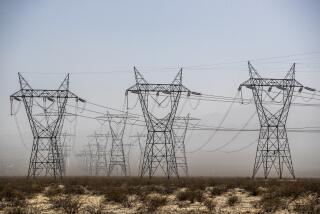Editorial: Of course Los Angeles shouldn’t spend billions on natural gas power plants
Policymakers in California have made some of the country’s most ambitious commitments to reducing climate-changing emissions. State lawmakers voted last year to set a target of 100% renewable and zero-carbon energy by 2045. And city leaders in Los Angeles have committed to generating all of the city’s electricity from clean, green sources and to make the city carbon neutral by 2050.
Still, California’s electrical grid has been so dependent on fossil fuels for so long that it can be unnerving for utilities — and downright scary for their customers — to mothball their old carbon-spewing power plants. A case in point: Until recently, the Los Angeles Department of Water and Power was planning to spend $2.2 billion to rebuild three natural-gas-fueled power plants along the coast. That investment would have kept L.A. reliant on fossil fuels for several more decades, and it would have sucked up money that could otherwise have been spent transitioning the local electrical grid to 100% renewable power.
DWP staff and consultants had insisted that the utility needed to keep the three plants running because renewable energy sources aren’t yet producing electricity reliably enough to replace them.
Los Angeles and the rest of the state will have to make some sacrifices — and some leaps of faith — to get off fossil fuels.
But this week, Mayor Eric Garcetti put a stop to that plan, arguing that the world’s climate crisis demands that utilities end their dependence on fossil fuels. He announced that the DWP will phase out the three gas-fueled power plants by 2029 and look to replace their megawatts with renewable power and battery storage.
Garcetti made the right choice. Seemingly every month brings another dire warning from climate researchers: Without significant action, global temperatures will increase enough by the end of the century to cause massive upheaval from rising seas, extreme weather, collapsing food chains, droughts and floods. The world has to slash greenhouse gas emissions.
Weaning electric utilities off fossil fuels is a scary business in part because nobody knows exactly how those plants will be replaced. The DWP, like most utilities in California, still relies on natural-gas-powered plants to provide electricity when power from renewable sources isn’t available or sufficient to meet the demand.
Industrial-scale batteries will make it much easier for utilities to draw a higher percentage of their power from renewables because they’ll be able to store electricity for when the sun isn’t shining or the wind isn’t blowing, but they are relatively new and expensive. Other power storage technologies are still in the nascent stage.
Past experience suggests that when leaders commit to phasing out fossil fuels in favor of renewable energy, the market responds. In 2002, when California enacted its first target for green energy, the state was heavily dependent on power from coal and natural gas. Within a few years, it became obvious that utilities could procure more than enough solar, wind and hydroelectric power to meet the initial targets; state lawmakers have since adopted more ambitious renewable-energy goals.
Illustrating the change in the market, NRG Energy dropped plans in 2017 to build a new natural-gas-fueled power plant on the Ventura County coast. State officials determined there were enough viable clean-energy alternatives and the gas-fired plant was not necessary.
The DWP is in a unique position. The city-owned utility is required by state law to shut down or rebuild the three gas-fueled plants on the coast because they use ocean water for cooling, which can harm marine life. Unless they are brought into compliance, the Scattergood plant in El Segundo must close in 2024, and the Harbor plant in Wilmington and the Haynes plant in Long Beach must close in 2029. The plants operate primarily in the summer months during peak electricity demand.
Enter the Fray: First takes on the news of the minute »
DWP officials said they may seek permission to keep all three plants open until 2029 to ensure reliable backup electricity as the utility builds out the transmission lines, solar panels and batteries needed to replace the lost megawatts. Utility leaders can’t say how much the transition will cost — a lot will depend on how quickly the technology develops and how swiftly prices drop.
The decision not to rebuild the plants is a calculated risk. The city could face summer brownouts if renewable sources can’t generate enough electricity to power Angelenos’ air conditioners. And electric rates could go up if the new sources of power and storage are significantly more costly than the current ones, which would crimp residents’ budgets and impede the city’s economic growth.
But Los Angeles and the rest of the state will have to make some sacrifices — and some leaps of faith — to get off fossil fuels. And transforming how we power our homes and businesses is absolutely vital to slowing climate change.
Follow the Opinion section on Twitter @latimesopinion and Facebook
More to Read
A cure for the common opinion
Get thought-provoking perspectives with our weekly newsletter.
You may occasionally receive promotional content from the Los Angeles Times.






